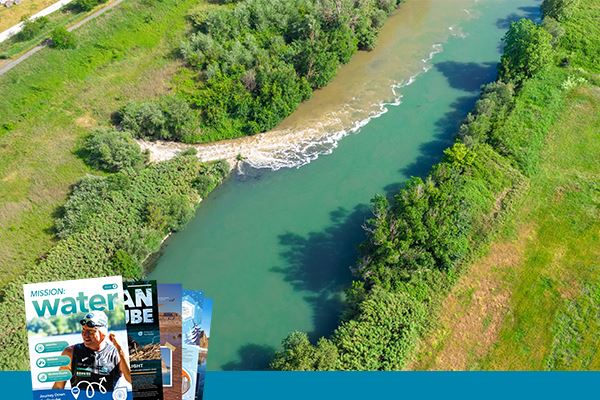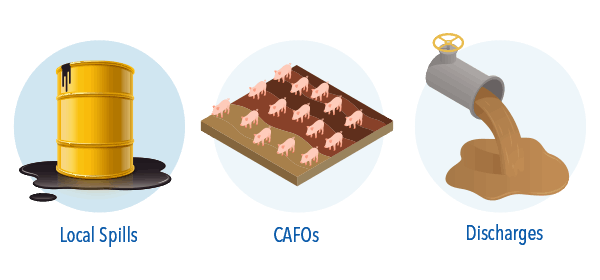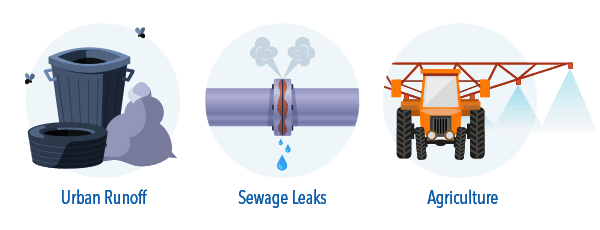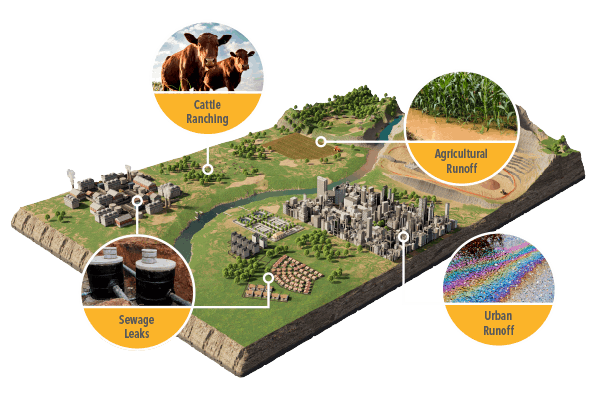Down to the Source | Understanding Point & Nonpoint Source Pollution

Point Source Pollution: The effluent from a wastewater treatment plant in Rome discharges into the Tiber River, Italy. This article is included in issue #9 of our Mission: Water magazine.
Monitoring water quality takes more than just the correct equipment. You must also understand the variables that affect a waterbody, including the potential sources of pollutants. It’s widely accepted that there are two main categories of water pollution—point and nonpoint sources.
Point Source

Point Source pollution refers to water quality concerns that can be traced back to a specific, discrete input to the waterbody. Examples of point sources and pollutants of concern:
- Wastewater Treatment Outfalls: nutrients, bacteria, sediment, pharmaceuticals
- Localized Spills: polycyclic aromatic hydrocarbons (PAHs), alkanes, fertilizer, microplastics, debris
- CAFOs (Concentrated Animal Feeding Operations): nutrients, bacteria, sediment, antibiotics
- Industrial Discharge: acid, Perfluoroalkyl & Polyfluoroalkyl Substances (PFAS), pharmaceuticals, plastics, solvents, heavy metals
Nonpoint Source

Nonpoint Source pollution comes from diffuse sources and is caused by runoff; it does not originate from specific locations in the watershed. Nonpoint sources are often difficult to define and the most challenging to trace with water quality monitoring. Examples of nonpoint sources and pollutants of concern:
- Urban Runoff: chemicals, debris, microplastics, sediment, bacteria
- Sewage Leaks: nutrients, turbidity, bacteria, pharmaceuticals
- Agricultural Runoff: nutrients, pesticides
- Cattle Ranching: sediment, nutrients, bacteria
A Straight-Forward Approach
Collecting water quality data for a point source can be simple if you have all the facts. For example, if a wastewater treatment plant finds that untreated water has been discharged, the water manager will need to collect some critical information.
You’ll want to know the time at which the discharge occurred, the duration, the approximate volume of effluent, and key pollutants that may be present that are indicative of the source. For wastewater effluent, a good indicator parameter might be high levels of nutrients, turbidity, chloride, or even biomarkers like caffeine.
Once you can identify the discharge in the water column, you can work to pinpoint downstream effects. Monitoring locations upstream, at or near the discharge/spill site, and downstream are ideal for monitoring water quality immediately after the event and for long-term monitoring plans. You’ll know to wrap up water quality monitoring once the levels of pollutants or parameters of concern return to upstream reference conditions.
A Challenging Task
Monitoring the effects of nonpoint source pollution in a waterbody is often more complex. Since this type of pollution is diffuse and carried by stormwater runoff throughout the watershed, you’ll need to develop an intimate understanding of your site and associated watershed characteristics.
It is important to understand the modes of transport of the pollutants of concern, the overall hydrology of the watershed, the number and types of inputs throughout, and the physiological and chemical interactions, both in sediment and in the water column.
A watershed management approach is essential to gather this information successfully. Some strategies involve not only monitoring your waterbody of interest, but also other locations upstream. A mathematical model of the watershed can be invaluable for simulating water and sediment transport.
These models can help predict how pollutants will migrate and interact with downstream features during baseflow and storm events. Software such as the Soil and Water Assessment Tool (SWAT) is instrumental in these predictions.
Other watershed-wide approaches include public outreach and education on the possible effects of nonpoint source pollution. For example, levels of turbidity that exceed national criteria may alert to a larger watershed problem. This can relate to wildfires, cattle farming, recreation, construction, bank erosion and destabilization, and other anthropogenic and natural activities.
Communicating with landowners and stakeholders in the watershed is a decisive step to raising awareness of damaging effects and initiating sustainable practices to improve water quality.

Examples of nonpoint sources include urban runoff, sewage leaks, agricultural runoff, and cattle ranching.
Regulating Pollution in Effluents
The National Pollution Discharge Elimination System (NPDES) is a program implemented by the Environmental Protection Agency (EPA) in the U.S. via the Clean Water Act (CWA) of 1972. It regulates point sources by authorizing state, territory, and tribal governments to issue permits and enforce water quality criteria. Permittees can discharge a defined amount of pollutant, keeping businesses and utilities operational yet compliant.
The CWA regulates nonpoint sources via Section 319, which allocates grant money to support watershed-level pollution mitigation projects, such as educational outreach, training, monitoring, and equipment funding. Best Management Practices (BMPs) strategically improve water quality by targeting overland flow, erosion, or grazing, to name a few. BMPs can be retention ponds, river engineering, revegetation, fencing, or compost blankets that reduce erosion, improve water flow, and remediate degraded water quality.
Characterizing the type of pollution affecting your waterbody is the first step to enacting a monitoring plan and remediation projects. With an understanding of point and nonpoint sources, you can help Solve Water!
